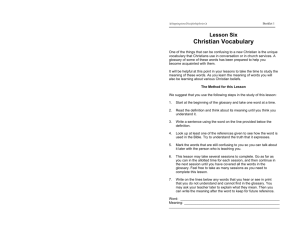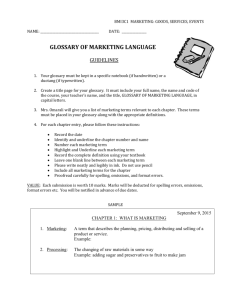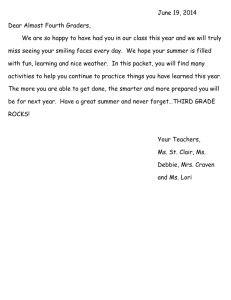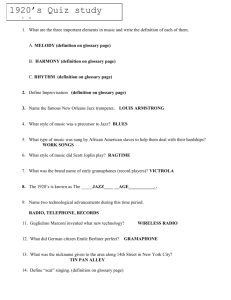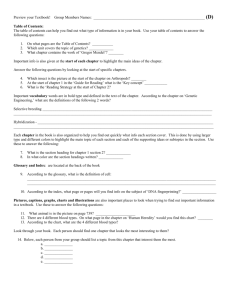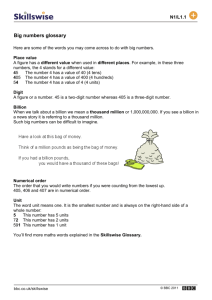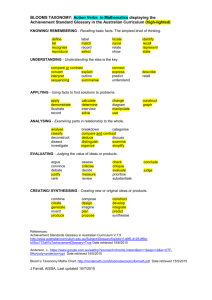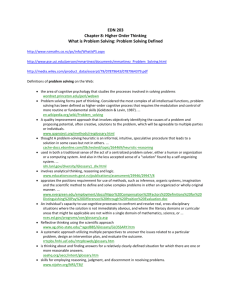GESD Glossary of Inst Elements.Teachers
advertisement
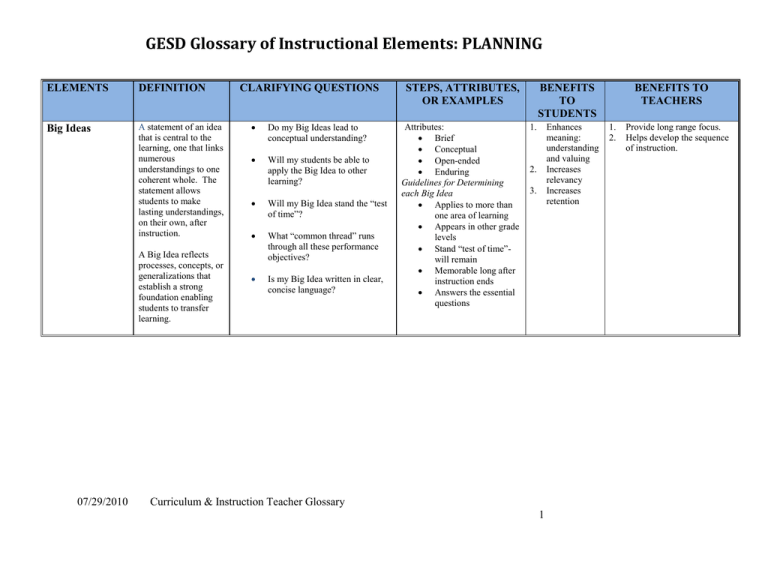
GESD Glossary of Instructional Elements: PLANNING ELEMENTS DEFINITION Big Ideas A statement of an idea that is central to the learning, one that links numerous understandings to one coherent whole. The statement allows students to make lasting understandings, on their own, after instruction. A Big Idea reflects processes, concepts, or generalizations that establish a strong foundation enabling students to transfer learning. 07/29/2010 CLARIFYING QUESTIONS Do my Big Ideas lead to conceptual understanding? Will my students be able to apply the Big Idea to other learning? Will my Big Idea stand the “test of time”? What “common thread” runs through all these performance objectives? Is my Big Idea written in clear, concise language? STEPS, ATTRIBUTES, OR EXAMPLES Attributes: Brief Conceptual Open-ended Enduring Guidelines for Determining each Big Idea Applies to more than one area of learning Appears in other grade levels Stand “test of time”will remain Memorable long after instruction ends Answers the essential questions BENEFITS TO STUDENTS 1. Enhances meaning: understanding and valuing Increases relevancy Increases retention 2. 3. Curriculum & Instruction Teacher Glossary 1 BENEFITS TO TEACHERS 1. 2. Provide long range focus. Helps develop the sequence of instruction. GESD Glossary of Instructional Elements: PLANNING ELEMENTS Essential Questions Performance Objective 07/29/2010 DEFINITION Mental questions, posed at the beginning of a unit, that are written in broad, organizational terms reflecting conceptual priorities. This objective must be taken from State Content Standards. The Standard, Strand, Concept and Performance Objective should be included. CLARIFYING QUESTIONS Do my Essential Questions relate to the Big Idea? Do my Essential Questions motivate my students to learn? Can my Essential Questions be answered with a “yes” or “no”? Are my Essential Questions connected to my Standards? Have I listed the Performance Objective in my plans? Have I selected the performance objective from the pacing guide? STEPS, ATTRIBUTES, OR EXAMPLES Attributes: Standards-based Succinct, open-ended, cannot be answered with “yes”, “no”, or mere recall of facts Require higher-level thinking skill One-two punch questions with content + higher-level thinking Provocative Each question should be distinct, substantial, and not repetitious Logical sequence to a set of questions Steps: Determine the sequence of instruction. Unwrap content objective by identifying knowledge of thinking skill. Determine if objective is content or process/skill. BENEFITS TO STUDENTS 1. 2. 3. 1. 2. Curriculum & Instruction Teacher Glossary 2 BENEFITS TO TEACHERS Enhances meaning: understanding and valuing Increases relevancy Increases retention 1. Aligned to expectation of state. Focuses students on what will be assesses by the state. 1. 2. 2. Easier to focus instruction on priorities Students more motivated when they know where learning is headed. Instruction match expectation Focuses on both content and process GESD Glossary of Instructional Elements: PLANNING ELEMENTS Pre-Assessment Selecting objective at the correct level of difficulty (SOCLD) 07/29/2010 DEFINITION CLARIFYING QUESTIONS STEPS, ATTRIBUTES, OR EXAMPLES BENEFITS TO STUDENTS Current, specific data about where to begin instruction for content and correct level of difficulty What data is available that will provide an accurate academic picture for lesson planning and instruction?( i.e previous lesson evaluation, running records, DIBELS progress monitoring, or benchmark assessments ) Review of previous skill Articulated, written, nonlinguistic representation For example: previous lesson evaluation, running records, DIBELS, progress monitoring, benchmark assessments, bellwork 1. The process of content task analysis 1. Assessing which essential objectives students do or do not know 2. Choosing the subobjectives to begin instruction at a point where all students can experience some success What do my students already know? Five Steps: 1. Formulate a Lesson Objective 2. Develop task analysis 3. Preassess 4. Interpret and analyze results 5. Determine where to begin 1. What do they still need to know and be able to do? Are there groups or individuals that will require a different level of instruction? 2. 2. 3. Curriculum & Instruction Teacher Glossary 3 BENEFITS TO TEACHERS Clear connection to previous learning Allows opportunities for clarification of previous concepts 1. Increases success rate Maintains challenge Lowers frustration level 1. 2. 2. Identifies need of student Provides focus for differentiation Organized way of planning Saves time GESD Glossary of Instructional Elements: PLANNING ELEMENTS Cognition Level/Critical Thinking Lesson Objective DEFINITION One of four levels of thinking defined by Marzano (2007) CLARIFYING QUESTIONS Am I designing objectives that include higher cognition levels? Do my lesson objectives increase in cognition level toward a culminating activity that requires Analysis or Knowledge Utlilization? A statement clarifying what the students are expected to know and be able to do and how teacher will assess evidence of student learning of performance objective(s) within a given lesson. Is it clear what my students should be able to know and do by the end of the lesson? Did I clearly state what evidence I will use to determine if students have learned? STEPS, ATTRIBUTES, OR EXAMPLES Types: Knowledge Retrieval Comprehension Analysis Knowledge Utilization 1. Develops students’ cognitive ability and experiences. BENEFITS TO TEACHERS 1. 2. 3. Increases student thinking Deepens meaning Develop flexibility of thought 2. Builds deeper understanding of content. Lesson Plan Objective: What (content) + How (process) + Evaluation (evidence) 07/29/2010 BENEFITS TO STUDENTS Aligned to state standards Clear Measurable Includes how the learning will be assessed Includes the evidence of rigor or criteria for success 1. Provides clarity of information, questions, and activities. 2. Focuses students’ efforts. Speeds learning. Curriculum & Instruction Teacher Glossary 4 1. 2. 3. Provides focus for all teacher actions Organization Less reteaching needed GESD Glossary of Instructional Elements: PLANNING ELEMENTS Language Objective Materials/ Resources 07/29/2010 DEFINITION CLARIFYING QUESTIONS A second teaching objective taken from the grade appropriate Content Standard in Reading, Writing, Speaking, or Listening or from the English Language Development Standards What literacy skills can be integrated with content area lesson objective? Print, electronic, visual resources used What materials/resources/ technology does the teacher and/or students need to accomplish the objective(s)? STEPS, ATTRIBUTES, OR EXAMPLES BENEFITS TO STUDENTS Attributes: Content or process skill included Consider how students receive and express information. Plan explicit oral or written expression. 1. Articulating thinking clarifies learning. 2. Attach precise terminology or academic vocabulary Steps: 1. Check alignment with content and process. 2. Ensure that the level of difficulty is appropriate for students. 3. Make resource accessible through pictures, role playing, explanation, building background, tape recording, etc. 1. Enhance understanding Supports information from teacher. Provides opportunities to construct knowledge. 2. 3. Curriculum & Instruction Teacher Glossary 5 BENEFITS TO TEACHERS 1. 2. 1. 2. Increase retention through processing Saves time Saves time Increase motivation of student GESD Glossary of Instructional Elements: PLANNING ELEMENTS Teaching to the Objective (Alignment) DEFINITION The ability of the teacher to keep most teacher actions aligned to one objective at a time. CLARIFYING QUESTIONS Do I only give information, responses, activities, and questions that align to the objective? By listening to short segments of the information or individual question/responses can students tell what the objective is? STEPS, ATTRIBUTES, OR EXAMPLES BENEFITS TO STUDENTS Teaching to the Objective Categories: Information Response Activities Questions 1. Four Steps: 1. Brainstorm skills necessary to reach terminal objective 2. Write subtopics starting with a verb (behavioral) 3. Delete unnecessary skills 4. Sequence the objectives 1. 2. 3. BENEFITS TO TEACHERS Focus/directi on Understandin g (Retention) Success (Motivation) 1. 2. 3. Organization Focus/direction Saves time/speeds learning Increases success rate Maintains challenge Lowers frustration level 1. Ensures that all essential components of learning are included Facilitates relevant teacher actions Facilitates teaching to higher levels of thinking Provides for long range planning Do the student actions exactly match the model and /or objective? Am I using precise terminology? Task Analysis of Lesson SubObjectives Breaking down the objective into smaller chunks/concepts or incremental steps and sequencing them for learning Have I left out any critical steps or components? Have I broken down the objective into small enough steps or components? Are my sub-objectives measurable, accurate, sequenced, and aligned to the objective? 07/29/2010 2. 3. 2. 3. 4. Add additional subobjectives needed for accommodations for subgroups that would benefit the whole class Curriculum & Instruction Teacher Glossary 6 GESD Glossary of Instructional Elements: FACILITATION ELEMENTS Teaching One Objective at a Time Meaning: Understanding DEFINITION The ability of the teacher to teach content or skills one sub-objective at a time The ability to help students know and comprehend the information. CLARIFYING QUESTIONS Am I teaching clearly one subobjective at a time? What can I do to make learning comprehensible and accessible to my students? Will a graphic organizer clarify the relationships of the content? 07/29/2010 STEPS, ATTRIBUTES, OR EXAMPLES BENEFITS TO STUDENTS Steps: 1. Construct lesson objectives. 2. Plan teacher actions, 3. Plan student actions 4. Plan check for understanding of each sub-skill 1. Examples: Clear directions or information Simple language or aligned to language proficiency level Examples Analogies 1. 2. 3. 4. 2. 3. BENEFITS TO TEACHERS Increases success rate Maintains challenge Lowers frustration level Allows opportunities to make adjustments within the lesson. 1. 2. Fewer student miscues Easier to check learning Clarifies learning Speeds learning Increases success 1. 2. 3. Makes learning more accessible Makes attributes or elements explicit Speeds learning Curriculum & Instruction Teacher Glossary 7 GESD Glossary of Instructional Elements: FACILITATION ELEMENTS Meaning: Understanding – Multisensory DEFINITION Engaging students with more than one sensory experience with the objective ideally simultaneously CLARIFYING QUESTIONS How can I increase the number of pathways to the brain? STEPS, ATTRIBUTES, OR EXAMPLES Types: Visual (see) Auditory (hear) Kinesthetic (manipulate) Olfactory (smell) BENEFITS TO STUDENTS 1. 2. 3. Examples: Graphic Organizers Manipulatives Anchor Charts Meaning: Building Background Knowledge/ Activating Prior Knowledge (Set) 07/29/2010 A mental process on the part of the students which allows the student to link past experience or background knowledge directly to the learning situation How do I help students make connections between what they already know and what will be presented to them? Attributes: Activity to connect to new learning Aligned to objective Past Experience 1. 2. 3. 4. BENEFITS TO TEACHERS Reinforces learning style strengths Strengthens weak learning styles All students benefit 1. 2. Speeds learning Saves time; less reteaching Helps transfer Increases speed of learning Directs students to focus on objective Adds meaning/relev ance to the lesson 1. 2. 3. Connects new learning to old Deepens discussion Reduces confusion Curriculum & Instruction Teacher Glossary 8 GESD Glossary of Instructional Elements: FACILITATION ELEMENTS Vocabulary Meaning: Valuing 07/29/2010 DEFINITION CLARIFYING QUESTIONS STEPS, ATTRIBUTES, OR EXAMPLES BENEFITS TO STUDENTS The key words or phrases that are critical to students gaining understanding or mastery with the content What are the academic vocabulary and/or key words the student must know to be successful with the lesson and performance objective? Types: Implicit – learned through listening and reading Explicit – directly taught with examples, descriptions, and non-linguistic representations 1. Speeds learning Increases understanding Reduces frustration Builds background knowledge 1. 2. Clarifies concepts and ideas Speeds learning Knowing the importance of what is being learned How can I help my students to value what is being learned or realize its importance to their lives? Examples: Personal need Relate to past experience Significant other to testify to its importance Teacher enthusiasm Answers the question, “Why/How is this important to me?” 1. 2. Makes teaching purposeful Increases student learning 2. 3. 4. Answers the question, “How/When am I going to use the information?” Curriculum & Instruction Teacher Glossary 9 BENEFITS TO TEACHERS GESD Glossary of Instructional Elements: FACILITATION ELEMENTS DEFINITION Model (procedural) Show process one step at a time with clearly labeled steps for the subobjective Model Model (metacognitive) Provide metacognition of process or rationale for decisions /conclusions while demonstrating or explaining the sub-objective with labels. 07/29/2010 CLARIFYING QUESTIONS What do I need to show and tell the students for each sub-objective that will help students accomplish the objective? How can I make a complex problem or product more explicit by explaining and showing what I am thinking? STEPS, ATTRIBUTES, OR EXAMPLES Attributes: Shows the correct performance Labels what makes the example correct. Explains metacognition for higher level thinking BENEFITS TO STUDENTS 1. 2. Speeds learning Increases retention BENEFITS TO TEACHERS 1. 2. Curriculum & Instruction Teacher Glossary 10 Saves time Results in higher quality student production and /or performance GESD Glossary of Instructional Elements: FACILITATION ELEMENTS Constructing Knowledge Guided Practice 07/29/2010 DEFINITION CLARIFYING QUESTIONS STEPS, ATTRIBUTES, OR EXAMPLES BENEFITS TO STUDENTS Conceptually developing deep student understanding through studentdirected inquiry experiences and scaffolding by the teacher Have I provided students opportunities to explore the concept before formal instruction? Attributes: Situated real-life learning task Student-directed inquiry Scaffolded questioning Specific labeled responses to affirm accurate learning 1. Students repeatedly practice correctly their new knowledge or skill under direct teacher supervision. How will I provide opportunities for students to practice individual sub-objectives with guidance? How will I use formation of groups to scaffold support of students? How will I provide opportunities for students to practice the entire lesson objective with guidance? Attributes: Aligned to instruction Meaningful amount Scaffolded support - under teacher supervision 2. 1. 2. 3. Learning transfers more readily Deeper understanding Eliminates incorrect learning Cements the learning Provides success Curriculum & Instruction Teacher Glossary 11 BENEFITS TO TEACHERS 1. 2. 1. 2. Makes learning connected to increase transfer Saves time Provide opportunity to clarify misconceptions Allows teacher time to check learning GESD Glossary of Instructional Elements: FACILITATION ELEMENTS Independent Practice Massed Practice 07/29/2010 DEFINITION CLARIFYING QUESTIONS Students have the opportunity to individually practice the skill or apply the content after demonstrating correct performance or understanding for the teacher Do my students need additional practice individually? How do I differentiate the practice? Have I made sure that the tasks are clearly aligned and do not introduce anything new? Providing opportunities for students to engage in the learning multiple times within a short period of time What skills or concepts have students been learning that still require additional practice to insure automaticity or understanding? How can I build into my lessons short bursts of practice back to back for the same objective? STEPS, ATTRIBUTES, OR EXAMPLES Aligned to instruction Meaningful amount Independent without teacher supervision. Can be homework but should not require the assistance of others Attributes: 1. Aligns to objective 2. Provides continued practice of same skill or concept BENEFITS TO STUDENTS 1. 2. 3. 1. 2. 3. Cements the learning from the lesson Aids in longterm retention Provides success Eliminates incorrect learning Aids success Aids retention Curriculum & Instruction Teacher Glossary 12 BENEFITS TO TEACHERS 1. 2. 1. 2. Allows opportunity to check student learning. Instructional decisions easier Increases accuracy Builds mastery. GESD Glossary of Instructional Elements: FACILITATION ELEMENTS Distributed Practice 07/29/2010 DEFINITION Provides additional spiraling opportunities throughout the year to practice previously learned content CLARIFYING QUESTIONS How can I use bell work to provide my students with practice of previously learned skills? How can I take advantage of short periods of remaining time to provide additional practice? (sponge activities as distributed practice) STEPS, ATTRIBUTES, OR EXAMPLES Attributes: 1. Include for previously mastered content 2. Practice is spread out and occurs before and after other new learning BENEFITS TO STUDENTS 1. 2. Increases retention Promotes transfer of learning Curriculum & Instruction Teacher Glossary 13 BENEFITS TO TEACHERS 1. 2. Reduces need to reteach Saves time GESD Glossary of Instructional Elements: FACILITATION ELEMENTS DEFINITION Check for Understanding/ Informal Assessment The ability of the teacher to elicit and check observable behavior of the each student and to act on the interpretation of that behavior to determine 1. if all or some students need more instruction or 2. if students are ready for independent practice or 3. if students are ready for the next subobjective. 07/29/2010 CLARIFYING QUESTIONS What strategies will I use to quickly check each student’s success with the subobjective? (i.e. signaling, response wheels, response boards) What will I do if some students are not successful? If the class is ready to move on to the next sub-objective, how will I intervene with those who are not successful? STEPS, ATTRIBUTES, OR EXAMPLES Steps: 1. Elicit overt behavior after each sub-objective 2. Check the behavior 3. Interpret the behavior 4. Determine whether to reteach subobjective or move on to next subobjective BENEFITS TO STUDENTS Catches errors quickly Facilitates feedback Evidence of success Avoids repetition of mistakes Curriculum & Instruction Teacher Glossary 14 BENEFITS TO TEACHERS 1. 2. Saves time Provide information to teacher on student learning. GESD Glossary of Instructional Elements: FACILITATION ELEMENTS DEFINITION CLARIFYING QUESTIONS Monitor and Adjust/ The ability of the teacher to elicit and check observable behavior of the each student and to adjust the instruction based on task analysis of the content or the instructional strategies. If students are not successful, how will I adjust my instruction to ensure all are successful? A mental process that allows the students to summarize the learning experience. How can I ask students to review or clarify key points of the lesson objective? Closure 07/29/2010 Do I need to adjust the subobjectives of my content or my instructional strategies. What can I ask student to explain or discuss that will help them tie everything together coherently? Tell/show me what you learned. STEPS, ATTRIBUTES, OR EXAMPLES Steps: 1. Elicit overt behavior 2. Check the behavior 3. Interpret misconception or breakdown in learning 4. Reteach using sub principles of learning to adjust strategies 5. Adjust the task analysis of the instructional strategies Attributes: Active Participation Relevancy / Alignment Summary by the Student BENEFITS TO STUDENTS 1. 2. 3. 1. 2. 3. Facilitates student success Avoids teacher and student frustration Avoids repetition of mistakes Evidence of success/reduce s frustration Summarizes and reinforces learning Aids transfer of learning Curriculum & Instruction Teacher Glossary 15 BENEFITS TO TEACHERS 1. 2. 3. 4. 5. Catches error quickly Identifies who understands Allows for grouping/individualization Reduces review time Ensures successful independent practice Assists teacher in determining the next step/the success of the lesson GESD Glossary of Instructional Elements: FACILITATION ELEMENTS End of Lesson Assessment DEFINITION An opportunity to measure student achievement of the lesson objective. CLARIFYING QUESTIONS Does my lesson assessment align to my objective? Have I challenged my students to the highest cognition level they are capable of? STEPS, ATTRIBUTES, OR EXAMPLES Attributes: Performance or product Measurable for both quantitative and qualitative criteria. Includes content and process BENEFITS TO STUDENTS 1. 2. Students have can measure their own success Future instruction is more likely to be at the correct level of difficulty 1 07/29/2010 Curriculum & Instruction Teacher Glossary 16 BENEFITS TO TEACHERS 1. 2. Provides opportunity to check mastery of information or skill. Grade information GESD Glossary of Instructional Elements: ENVIRONMENT 1 ELEMENTS MOTIVATION Motivation: Level of Concern DEFINITION A student’s intent or desire to learn. A state of anticipation or anxiety about what is going to happen next CLARIFYING QUESTIONS How can I motivate my students to give their best efforts and commit to learning? What can I state to students that will increase their concern about what they must complete or learn? How can I use time to help students pace their efforts and increase their focus? STEPS, ATTRIBUTES, OR EXAMPLES BENEFITS TO STUDENTS Listed from strongest to weakest variable of motivation: Level of Concern Success Knowledge of Results Interest Feeling Tone 1. Increases participation 2. Maximizes achievement Types: Accountability Time Proximity 1.Increases participation 2.Maximizes achievement Where or by whom can I position myself in the classroom to increase student effort and focus? 07/29/2010 Curriculum & Instruction Teacher Glossary 17 BENEFITS TO TEACHERS 1. 2. Makes class time more enjoyable Minimizes discipline 1. 2. Minimizes discipline problems Increases time on task GESD Glossary of Instructional Elements: ENVIRONMENT ELEMENTS Motivation: Success Motivation: Knowledge of Results DEFINITION The feeling of making progress toward an achievable goal Specific and immediate feedback to the student CLARIFYING QUESTIONS STEPS, ATTRIBUTES, OR EXAMPLES BENEFITS TO STUDENTS How can I communicate the progress the class is making to encourage them to keep trying? How can I communicate the success an individual student is making on part of a problem to inspire the student to overcome an obstacle? Examples: Faster More accurate Able to demonstrate new learning 1. How can I respond to students so that they can readily know how well they are learning the sub-objective? Attributes: Immediate Specific 1. 2. 3. 2. 3. 07/29/2010 Minimizes discipline problems Increases time on task Success breeds success Awareness of the accuracy or quality of performance or response Positive reinforcement Leads to increased accuracy Curriculum & Instruction Teacher Glossary 18 BENEFITS TO TEACHERS 1. 2. 3. Minimizes discipline problems Increases time on task Success breeds success 1. Reduces time needed for review. 2. Increases participation in lesson. GESD Glossary of Instructional Elements: ENVIRONMENT ELEMENTS Motivation: Interest DEFINITION Enthusiasm for a lesson or task CLARIFYING QUESTIONS How can I connect the lesson information or objective to topics that are appealing to students? How can I use student names to generate enthusiasm about the lesson content or objective? Motivation: Feeling Tone The internal state of the learner toward the learning environment. What unusual or sensory experience (color, tactile, role play or drama, pictures) would increase enthusiasm for the lesson objective or content? How can I adjust the environment to increase student comfort or anxiety? STEPS, ATTRIBUTES, OR EXAMPLES BENEFITS TO STUDENTS Attributes: 1. Vividness 2. Novelty 3. Importance to students 1. Examples: Pleasant Unpleasant Neutral 1. 2. 2. More enjoyable Increases attentiveness Increases anxiety Decreases anxiety 1 07/29/2010 Curriculum & Instruction Teacher Glossary 19 BENEFITS TO TEACHERS 1. 2. 3. Minimizes discipline problems Increases desire to learn Increases student attentiveness 1. 2. Increase acceptable student behavior and response Builds relationships GESD Glossary of Instructional Elements: ENGAGEMENT ELEMENTS Active Participation DEFINITION Consistent student engagement throughout the lesson that promotes learning of the objective by all the students CLARIFYING QUESTIONS What will I do to help students effectively interact with new knowledge? What will I do to ensure that students mentally process the new information? How will formation of groups be used in activities? How will I generate student to student learning conversations? How will make sure participation is mandatory and maintain individual accountability? 07/29/2010 STEPS, ATTRIBUTES, OR EXAMPLES Attributes: Mental processing of information that promotes learning the objective Questions or activities elicited by the teacher that require individual accountability to demonstrate learning (wait time, non-volunteers, covert first, then overt, show work) Student to student or student to teacher Most of the students Most of the time Forms: overt (observable action)and covert (mental thinking) BENEFITS TO STUDENTS 1. 2. 3. Aids meaning Increases time on task Increases speed of learning Curriculum & Instruction Teacher Glossary 20 BENEFITS TO TEACHERS 1. 2. 3. 4. Minimizes discipline problems Assists in monitoring and adjusting Decreases need for review Increases success GESD Glossary of Instructional Elements: ENGAGEMENT ELEMENTS DEFINITION Structured Interactive Language Development Strategies the teacher uses to promote student to student communication and development of academic language skills CLARIFYING QUESTIONS Am I ensuring that at least 50% of the time students verbalize their thinking with one another using academic language? Am I providing students with opportunities to use specific vocabulary and language structures? Am I expecting students to apply higher levels of language structures while interacting? Cognition Level/Critical Thinking 07/29/2010 One of four levels of cognition defined by Marzano (2007) Am I structuring ahead of time the academic talk for students to use during a lesson? Am I designing objectives at higher cognition levels? Do my lesson objectives increase in cognition level toward a culminating activity that requires Analysis or Knowledge Utilization? STEPS, ATTRIBUTES, OR EXAMPLES BENEFITS TO STUDENTS Attributes: Students are required to speak in complete sentences. Student to student conversations at least 50% of time Students justify responses Students use language structures that correlate with critical thinking skills (Marzano) 1. Attributes: Knowledge Retrieval Comprehension Analysis Knowledge Utilization 1. 2. 3. 4. 2. Increase academic language proficiency. Articulate thinking. Clearly express justification for answers. Develop higher cognitive structures of thought by using higher levels of language structures Develops students’ cognitive ability and experiences. Builds deeper understanding of content. Curriculum & Instruction Teacher Glossary 21 BENEFITS TO TEACHERS 1. 2. 1. 2. 3. Increase learning through articulation and process Builds vocabulary Increase student critical thinking Deepens meaning Develop flexibility of thought GESD Glossary of Instructional Elements: ENGAGEMENT ELEMENTS DEFINITION Formation of Groups Using whole or flexible small groups to introduce or practice concepts with accessible material. Using data to determine the specific needs & grouping students to provide instruction at the correct level of difficulty. CLARIFYING QUESTIONS Do most of the students in the group need these skills or concepts? What do I need to do to make the information or text accessible for all? What does data tell me about the specific needs of students? Which students can be placed in groups for specific skill development? STEPS, ATTRIBUTES, OR EXAMPLES BENEFITS TO STUDENTS Attributes: Whole group instruction to move the majority of the students forward. Small, flexible groups meet individual needs for reteaching, application, or enrichment & acceleration 1. 2. Continuous progress for all students. Adjustment for individual needs. Do I need to change the groups to better meet students’ needs on a new concept? 2 07/29/2010 Curriculum & Instruction Teacher Glossary 22 BENEFITS TO TEACHERS 1. 2. 3. Provides success for all Increases desire to learn Reduces discipline and time off task
